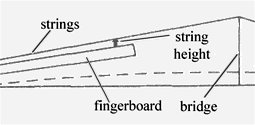

 INSIGHTS: ROUTINE CHECK AND COMMON PROBLEMS (I) INSIGHTS: ROUTINE CHECK AND COMMON PROBLEMS (I)
When your violin, viola or cello is sent to a repairer, the luthier will conduct a series of checks to determine the condition of your instrument and recommend the services required to rectify the problems found or to improve the playability or sound of your instrument.
In this article, we will look at some common problems of stringed instruments that will tell us what the luthier is looking for when conducting his/her series of checks. STRING HEIGHT A player may need extra effort to press his/her fingers onto the fingerboard and thus feel some discomfort. This may be because the string height is too high. 
The pulling force exerted by tightened strings on the peg box and the downward force exerted by playing, causes a resultant upward force on the violin neck. This will in turn cause the string height to increase. 
SOUNDPOST NOT LONG ENOUGH The soundpost may need to be changed when the f-holes collapse to a suspicious level, and when the player feels the response of the instrument becomes sluggish. The situation where the soundpost is not long enough often happens to new instruments. Either insufficient care was given to the soundpost during violin-making or the unseasoned wood that will shrink with time is used for the soundpost. WARPED BRIDGE With normal use of your stringed instrument, the bridge will gradually lean either in the direction of the pegs or the fine-tuners. If left un-straightened, the bridge will eventually warp under string tension. A bridge may also warp due to poor quality of wood used for the bridge and humidity changes. A warped bridge adversely affects the tone of your instrument greatly and must be replaced if the warp is too severe. POORLY LUBRICATED PEGS Humidity changes may cause the lubricating compound on the pegs to dry up, causing difficult turning of the pegs. In humid conditions like those of Singapore, lubricants of fatty base will be appropriate. Humidity changes can also cause a violin's shape to change in a complex fashion as well. This is one reason why pegs cannot turn smoothly due to changes in the size and shape of the pegbox and the pegs. STRING LENGTH RATIO A correct string length ratio is necessary for easy playability and the production of a good tone. The ratio may be altered by adjusting the bridge and the position of the tailpiece. It is also determined by how the player wants his/her instrument to sound. The adjustment of the string length ratio may produce great variations on some violins but differences may be less distinct on others. 
LUBRICATION AT NUT AND BRIDGE The luthier will check to see if there is sufficient lubrication at the nut and bridge to allow easy tuning. This is also to prevent the strings from wearing off. BOW CAMBER Problems with the bow camber may be due to losing its "spring" over time, its inherent poor construction, or even over-tightening . These can cause problems with response and uneven strokes. Re-cambering of the bow may thus be required. |






